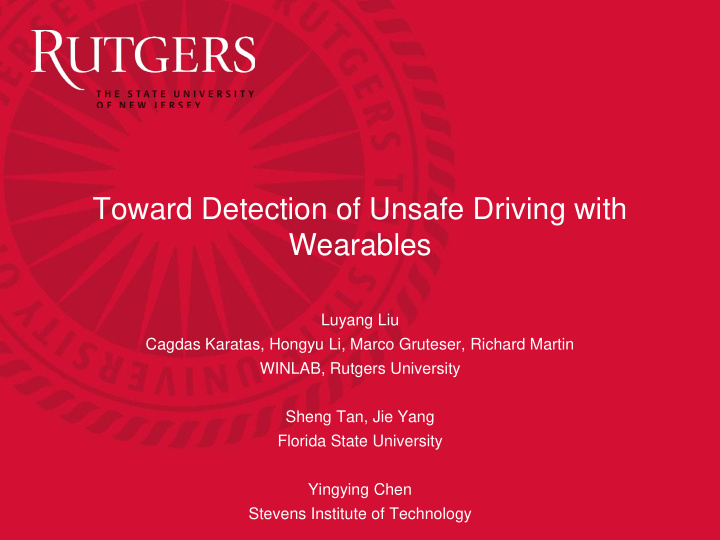



Toward Detection of Unsafe Driving with Wearables Luyang Liu Cagdas Karatas, Hongyu Li, Marco Gruteser, Richard Martin WINLAB, Rutgers University Sheng Tan, Jie Yang Florida State University Yingying Chen Stevens Institute of Technology
Smart devices — distractions and opportunities 2 Existing Cell Phone Blocking Apps Cell phone use and texting bans
Related works • Driver or passenger: Recognize when their user is driving and distinguish that from being a passenger. NFC based Vehicle dynamics based Audio infrastructure based • Safe or unsafe: Detect unsafe driving behaviors with mobile sensing techniques. Carsafe app Driver behavior profiling using smartphones 3
Towards unsafe driving with wearables Smart watch data is useful for tracking hand movements — most notably steering wheel usage. 4
Objectives and approaches • Driver detection: • Detect driver or passenger with wearables accurately. Using phone Eating Steering wheel • Steering wheel angle Estimate steering wheel turning angle with wearables. • Safe or unsafe(future work): Detect unsafe driving behaviors with wearables. 5
System overview • Collected data from sensors of smartphone and smartwatch. • Developed turn detection algorithm. • Extracted features from turn period to do driver passenger detection. • Developed steering wheel angle monitoring method. 6
Turn detection 7
Feature extraction Features Brief Intro Rotational change 3-axis vector of the rotational change when the wearable has maximum rotations. Hand acceleration 3-axis acceleration vector of the wearable when the wearable has maximum acceleration. Car acceleration 3-axis acceleration vector of the phone when the phone has maximum acceleration. Car rotation Overall rotation of the car during the entire turn period. First hand The maximum gyroscope value during the first movement hand movement and its duration. 8
Rotational change How to eliminate the effect of vehicle? 9
Rotational change • Use quaternion of both smartphone and smartwatch to get the rotational changes of smartwatch in car’s coordinate frame. • Eliminate the effect car rotation • Find the rotation of the watch relative to watch’s initial coordinate frame. • Use the maximum absolute value of Euler angles in the individual axes as the rotational change feature vector. 10
Acceleration • Hand acceleration • Calculates watch’s acceleration relative to its initial coordinate frame during entire turn period and the maximum of calculated acceleration is chosen as the feature. • Car acceleration • Uses same method to get car acceleration feature. 11
Other features • First hand movement: • The maximum of watch’s gyroscope value is selected to express the maximum rotation velocity during this movement. • Besides, the time duration of the movement is also selected, since passenger’s hand movements are usually shorter than drivers. • Car rotation: • Overall rotation of the car during the entire turn period. 12
Experiment setup • We conduct our experiments with 3 Invensense MPU-9150 9- axis motion sensor. • The sample rate is set as 100Hz in the experiments. 13
Dataset • Sensor data is collected from several hours’ drives, total 280 turns (560 cases). • In the whole data set, passenger might be stationary, using phone or eating. • Labeled ground truth. • Turn period. • Different passenger motions.(Stationary, using phone and eating). 14
Classification and evaluation • Turn detection • For our limited dataset, we did not find any false positives. • Driver detection 98.9% 100% 100% 96.7% 15
Steering Wheel Turning Angle Estimation • Coordinate system alignment: • Converts the gyroscope readings of the smart watch to the steering wheel's coordinate system. • Steering wheel angle • Accumulate the gyroscope reading on steering wheel's plane to get the smart watch turning angle. • Angle mapping: • Collect training data to create a mapping method between the rotations of the smart watch and the steering wheel under different steering turning angles. 16
Evaluation 17
Conclusions and future work • We used wrist-mounted sensors to track steering wheel usage and inputs. • Our experiments show promising results for both driver passenger detection and steering wheel angle estimation. • The steering wheel angle estimation is not robust enough for more complex driving scenarios. • Power consumption of smart watch is still a big issue. • Combine steering wheel turning angles with other measurements to detect unsafe driving behaviors. 18
Questions?
Thank you!
Recommend
More recommend